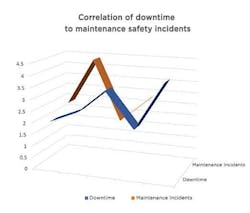With a tight job market and the growing need for skilled workers, retaining qualified operators is paramount. Keeping workers safe on the plant floor requires a strong commitment to training and communication. Land O’Lakes’ Senior Asset Reliability Manager Mark Hanley provides insight on how food and beverage manufacturers can implement effective worker safety programs.
PFW: How does Land O’Lakes address worker safety?
Hanley: One of our company’s focuses is understanding the safety involved with nonroutine work. To do this, we look at aligning with the Worker Safety Readiness tool from PMMI’s OpX Leadership Network. We look at the safety culture and the safety plan we adhere to, both with behavior and equipment.
One of the questions that comes up is: What is nonroutine work? Nonroutine work is anything that is not planned or scheduled, such as predictive maintenance, preventive maintenance or planned work, where you have the job safety analysis already written.
In other words, it’s a breakdown or emergency, blockages or jams, or it could also involve new employees doing a task that they’re not familiar with or in an unfamiliar location.
PFW: How do you define a safety program?
Hanley: Some of the things we looked at are defining safety routines and a program that involves the understanding of your environment. Examples include how the plant runs, how the equipment runs, the training involved, any contingency plans you may have in place, and the differences in products. Additionally, you need to understand the work. What jobs are associated with each asset? What documentation needs to be developed? Is it an energized electrical work permit, safety permit, a lockout-tagout, etc.?
PFW: How should a plant proceed?
Hanley: Once a safety program is developed, it needs to be reviewed annually. It is a living process and must continue to evolve. You must make a commitment to your worker safety plan.The communication portion of the program is key and should set expectations for employees. At Land O’Lakes, we make sure employees understand what safety means to the company and what safety means to operators in a way they can clearly understand.
PFW: Can you provide specific examples of how a safety plan should be implemented?
Hanley: It’s important to have a solid onboarding process and provide adequate training from staff who are qualified or certified on equipment operation, such as training with environment, health and safety (EHS) and maintenance groups, to understand where hazards could be in the equipment.
For example, we hold conference calls individually with new mechanics in their first two to three weeks of employment. Our director of EHS and I speak with them for 15 to 30 minutes to discuss safety protocols and their part in safety. We also express our concern for them going home the same way they came to us, if not better. After this discussion, our director of manufacturing speaks to them during plant visits. We want to build a viable safety culture through this. We can have all the strategies we want, but don’t forget that culture eats strategy for lunch.
PFW: How do you ensure the best safety culture?
Hanley: When your safety program is executed and well-maintained, it becomes part of a company’s core values. You’ve done your communication and safety plan, set the expectations, built a solid training program, but now it needs to be sustained. Report tracking and regulatory policies must be in place. You must have discussions if there are variations in any of your key performance indicators.
We have a definite and strong commitment to our safety plan. We believe that it is No. 1 in everything we do. This comes from our CEO, right down to plant leadership and staff.
You must communicate the importance of employee well-being, emphasizing that there’s no production that is worth someone rushing through just to get the line back up.
Learn more about improving worker safety on the plant floor at PACK EXPO Las Vegas from Sept. 23-25 at the Las Vegas Convention Center.
Leaders relevant to this article:

